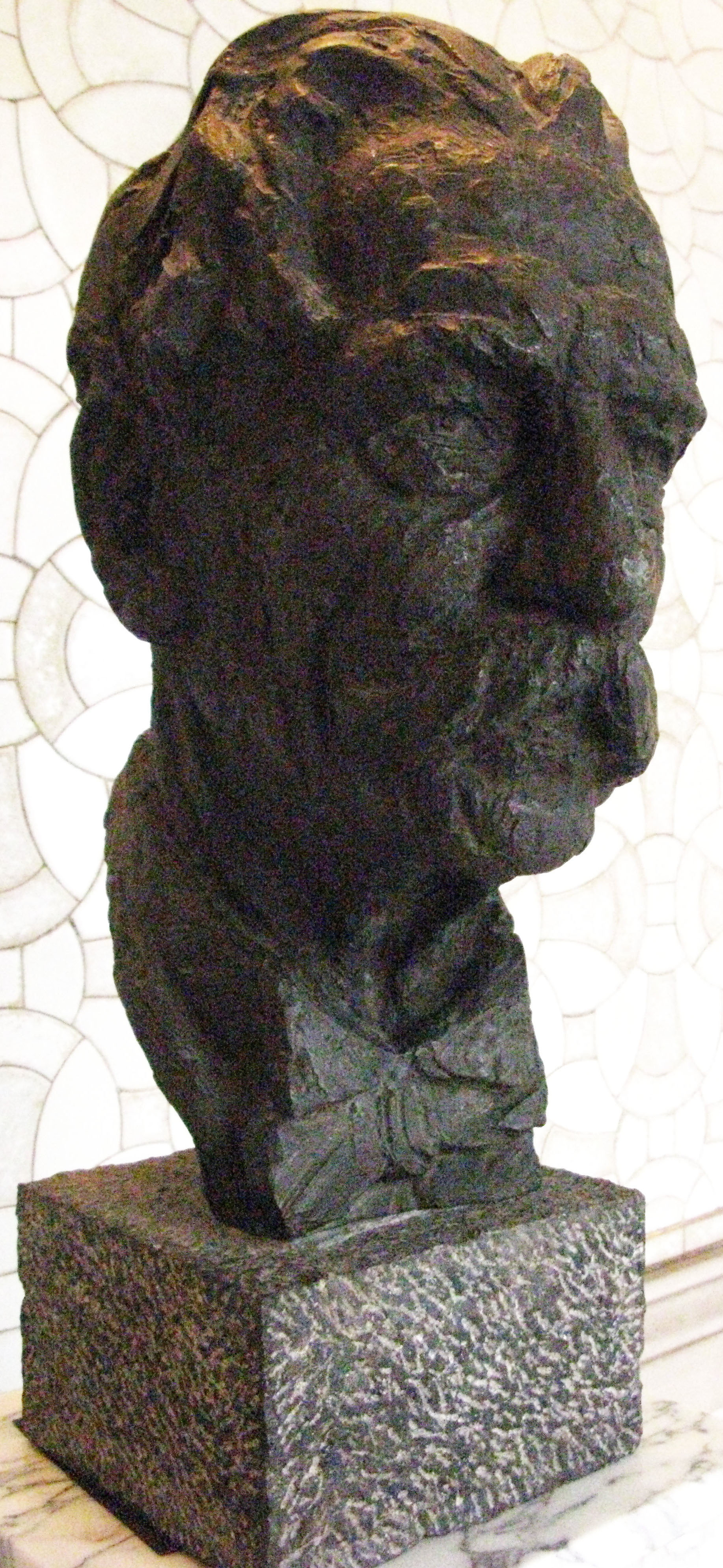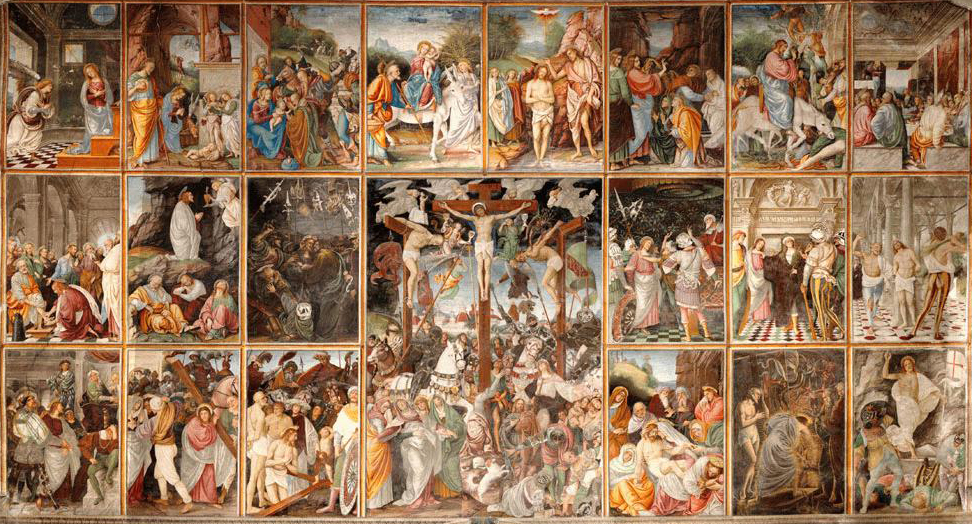
Albert Schweitzer [source: wikipedia]
Schweitzer believes that Strauss laid the foundation for the Quest of the Historical Jesus, which Schweitzer famously championed, and believed Strauss formalized the demythologization as a theological disciplined that had not be clearly grasped by his predecessors. Schweitzer may be seeing too much of himself in Strauss at the bottom of a dimly lit well, but Schweitzer's positive appraisal of Strauss' work and moving introduction to the hardships of Strauss' life cannot be ignored. Schweitzer does not receive Strauss without criticism, and he is quick to point out that Strauss has not seen the benefit of eschatology (which Schweitzer is well known for his infamous contributions to apocalyptic aspects of Jesus) and to note that Strauss did not comprehend the Marcan priority of the Gospels.
In Chapter 8: "Strauss's First Life of Jesus", Schweitzer provides and excellent summary of the most notable parts of D.F. Strauss' massive tome (my copy of the Life of Jesus is consolidated to 800 pages, but the first edition was over 1,400 pages). Many theologians are willing to allow the category of myth to bible before Jesus' baptism and after his ascension, but Strauss made no such exemption, compromise or concession. The Life of Jesus directly address the inner bounded set that was off limit to his contemporaries and predecessors. In the following extended quotation from The Quest of the Historical Jesus [amazon], a summary of this massive tome is eloquently abridged to a few pages in the eloquence that few like Schweitzer posses. This is an excellent taste of Schweitzer that represents my experience after plowing through the super-majority of Strauss' Life of Jesus.
 Gaudenzio Ferrari, Life of Jesus [source: wikipedia] |
![David Friedrich Strauss [source: wikipedia]](https://postbarthian.com/wp-content/uploads/2014/11/David_Friedrich_Strauss_1-2.jpg) David Friedrich Strauss |
The final statement in this quotation is key, because though its been 180 years since Strauss first published The Life of Jesus it is still a current book in theological discussion to this day, even if only as a historical marker in the development of academic studies, it is the one 'Life of Jesus' that surpasses all the so-called 'Lives of Jesus' genre of publications.
In the stories prior to the baptism, everything is myth. The narratives are woven on the pattern of Old Testament prototypes, with modifications due to Messianic or messianically interpreted passages. Since Jesus and the Baptist came into contact with one another later, it is felt necessary to represent their parents as having been connected. The attempts to construct Davidic genealogies for Jesus, show us that there was a period in the formation of the Gospel History during which the Lord was simply regarded as the son of Joseph and Mary, otherwise genealogical studies of this kind would not have been undertaken. Even in the story of the twelve-year-old Jesus in the temple, there is scarcely more than a trace of historical material.
In the narrative of the baptism we may take it as certainly unhistorical that the Baptist received a revelation of the Messianic dignity of Jesus, otherwise he could not later have come to doubt this. Whether his message to Jesus is historical must be left an open question; its possibility depends on whether the nature of his confinement admitted of such communication with the outer world. Might not a natural reluctance to allow the Baptist to depart this life without at least a dawning recognition of the Messiahship of Jesus have here led to the insertion of a legendary trait into the tradition? If so, the historical residuum would be that Jesus was for a time one of the adherents of the Baptist, and was baptized by him, and that He soon afterwards appeared in Galilee with the same message which John had proclaimed, and even when He had outgrown his influence, never ceased to hold John in high esteem, as is shown by the eulogy which He pronounced upon him. But if the baptism of John was a baptism of repentance with a view to "him who was to come," Jesus cannot have held Himself to be sinless when He submitted to it. Otherwise we should have to suppose that He did it merely for appearance' sake. Whether it was in the moment of the baptism that the consciousness of His Messiahship dawned upon Him, we cannot tell. This only is certain, that the conception of Jesus as having been endowed with the Spirit at His baptism, was independent of, and earlier than, that other conception which held Him to have been supernaturally born of the Spirit. We have, therefore, in the Synoptists several different strata of legend and narrative, which in some cases intersect and in some are superimposed one upon the other.
The story of the temptation is equally unsatisfactory, whether it be interpreted as supernatural, or as symbolical either of an inward struggle or of external events (as for example in Venturini's interpretation of it, where the part of the Tempter is played by a Pharisee) ; it is simply primitive Christian legend, woven together out of Old Testament suggestions.
The call of the first disciples cannot have happened as it is narrated, without their having known anything of Jesus beforehand; the manner of the call is modelled upon the call of Elisha by Elijah. The further legend attached to it—Peter's miraculous draught of fishes—has arisen out of the saying about "fishers of men," and the same idea is reflected, at a different angle of refraction, in John xxi. The mission of the seventy is unhistorical.
Whether the cleansing of the temple is historical, or whether it arose out of a Messianic application of the text, "My house shall be called a house of prayer," cannot be determined. The difficulty of forming a clear idea of the circumstances is not easily to be removed. How freely the historical material has been worked up, is seen in the groups of stories which have grown out of a single incident; as, for example, the anointing of Jesus at Bethany by an unknown woman, out of which Luke has made an anointing by a penitent sinner, and John an anointing by Mary of Bethany.
As regards the healings, some of them are certainly historical, but not in the form in which tradition has preserved them. The recognition of Jesus as Messiah by the demons immediately arouses suspicion. It is doubtless rather to be ascribed to the tendency which grew up later to represent Him as receiving, in His Messianic character, homage even from the world of evil spirits, than to any advantage in respect of clearness of insight which distinguished the mentally deranged, in comparison with their contemporaries. The cure of the demoniac in the synagogue at Capernaum may well be historical, but, in other cases, the procedure is so often raised into the region of the miraculous that a psychical influence of Jesus upon the sufferer no longer suffices to explain it; the creative activity of legend must have come in to confuse the account of what really happened.
One cure has sometimes given rise to three or four narratives. Sometimes we can still recognise the influences which have contributed to mould a story. When, for example, the disciples are unable to heal the lunatic boy during Jesus' absence on the Mount of Transfiguration, we are reminded of 2 Kings iv., where Elisha's servant Gehazi tries in vain to bring the dead boy to life by using the staff of the prophet. The immediate healing of leprosy has its prototype in the story of Naaman the Syrian. The story of the ten lepers shows so clearly a didactic tendency that its historic value is thereby rendered doubtful.
The cures of blindness all go back to the case of the blind man at Jericho. But who can say how far this is itself historical? The cures of paralytics, too, belong rather to the equipment of the Messiah than to history. The cures through touching clothes, and the healings at a distance, have myth written on their foreheads. The fact is, the Messiah must equal, nay, surpass, the deeds of the prophets. That is why raising from the dead figure among His miracles.
The nature miracles, over a collection of which Strauss puts the heading "Sea-Stories and Fish-Stories," have a much larger admixture of the mythical. His opponents took him severely to task for this irreverent superscription.
The repetition of the story of the feeding of the multitude arouses suspicion regarding the credibility of what is narrated, and at once invalidates the hypothesis of the apostolic authorship of the Gospel of Matthew. Moreover, the incident was so naturally suggested by Old Testament examples that it would have been a miracle if such a story had not found its way into the Life of Jesus. An explanation on the analogy of an expedited process of nature, is here, as in the case of the miracle at Cana also, to be absolutely rejected. Strauss allows it to be laughed out of court. The cursing of the fig-tree and its fulfilment go back in some way or other to a parable of Jesus, which was afterwards made into history.
More important than the miracles heretofore mentioned are those which have to do with Jesus Himself and mark the crises of His history. The transfiguration had to find a place in the life of Jesus, because of the shining of Moses' countenance. In dealing with the narratives of the resurrection it is evident that we must distinguish two different strata of legend, an older one, represented by Matthew, which knew only of appearances in Galilee, and a later, in which the Galilaean appearances are excluded in favour of appearances in Jerusalem. In both cases, however, the narratives are mythical. In any attempt to explain them we are forced on one horn of the dilemma or the other—if the resurrection was real, the death was not real, and vice versa. That the ascension is a myth is self-evident.
Such, and so radical, are the results at which Strauss's criticism of the supernaturalistic and the rationalistic explanations of the life of Jesus ultimately arrives.
In reading Strauss's discussions one is not so much struck with their radical character, because of the admirable dialectic skill with which he shows the total impossibility of any explanation which does not take account of myth. On the whole, the supernaturalistic explanation, which at least represents the plain sense of the narratives, comes off much better than the rationalistic, the artificiality of which is everywhere remorselessly exposed.
The sections which we have summarized are far from having lost their significance at the present day. They marked out the ground which is now occupied by modern critical study. And they filled in the death-certificates of a whole series of explanations which, at first sight, have all the air of being alive, but are not really so. If these continue to haunt present-day theology, it is only as ghosts, which can be put to flight by simply pronouncing the name of David Friedrich Strauss, and which would long ago have ceased to "walk," if the theologians who regard Strauss's book as obsolete would only take the trouble to read it.
Schweitzer, Albert. Ed. James M. Robinson. The Quest of the Historical Jesus: A Critical Study of Its Progress from Reimarus to Wrede. Trans. W. Montgomery. New York: Macmillan, 1968. 81-84. Print.



Leave a comment